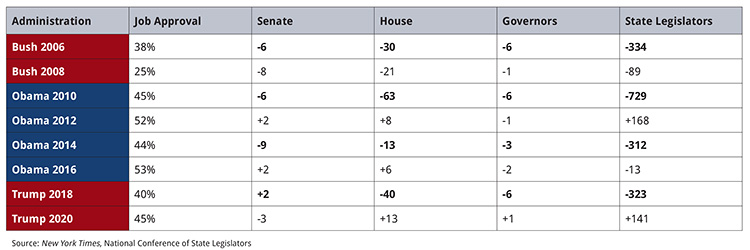In the 2018 midterm elections in Wisconsin, Democrats ran the table in all statewide constitutional offices for the first time since 1982. Democrats defeated three incumbent Republicans — Gov. Scott Walker, Attorney General Brad Schimel and Lt. Gov. Rebecca Kleefisch — and won the open seat race for State Treasurer. U.S. Sen. Tammy Baldwin was also easily reelected to a second six-year term.
With the exception of the U.S. Senate race, the victorious statewide Democrats defeated their Republican opponents by very slim margins. But a win is certainly a win, and one of the primary reasons for Democrats’ success was former President Donald Trump.
The 2018 election was President Trump’s one and only midterm election, and history shows that the president’s party loses seats at the federal, state and local level in midterm elections. 2018 was a very good election cycle for Democrats across the country and in Wisconsin. With the lone exception of Republican Sen. Ron Johnson, Democrats today hold all the other constitutional offices in Wisconsin.
Political scientists and election prognosticators generally agree that midterms serve as a referendum on the incumbent president and that president’s record. Looking ahead to next year with history as a guide, what might the election landscape look like in the 2022 midterm elections with President Joe Biden now occupying the White House?
Wisconsin 2022
The 2022 midterm elections in Wisconsin will include these statewide constitutional offices: Democrats Gov. Tony Evers, Lt. Gov. Mandela Barnes and Attorney General Josh Kaul. At the federal level, State Treasurer Sarah Godlewski has entered the race for U.S. Senate against GOP Sen. Ron Johnson. Sen. Johnson, however, has not decided if he will run for a third term in 2022.
If longtime historical midterm election results hold true, 2022 will likely not be a good election year for Democrats. President Biden and Democrats control all levers of power in Washington, and the political fallout from federal single-party control is typically bad to very bad for the party in power. The chart below illustrates the political damage midterm elections generate for the party of the president on both sides over the last 15 years. The four midterm elections — 2006, 2010, 2014 and 2018 — appear in bold.


Here are additional historical facts to keep in mind as we look ahead to next year’s midterm election.
Federal elections
According to the Cook Political Report, since the end of World War II, the party of the president has suffered an average loss of three U.S. Senate and 22 House seats in midterm elections. More specifically, first-term midterm elections — think 2022 — have cost their parties one Senate seat and 23 House seats. Democrats currently hold a narrow 218-212 majority in the House, and the Senate is split 50-50, so losing even a single seat will switch party control of the U.S. Senate. With their slim majorities in both houses of Congress, even a modestly bad election night next year could result in a GOP takeover of one or both chambers.
State elections
Looking back over the last 15 years, the number of midterm election seat losses in state elections has been significant. As you can see from the chart on the previous page, the party in power lost seats in gubernatorial and state legislative districts across the board in midterms. Voters have been voting against whoever is in power for the past 15 years.
Wisconsin governors
In a recent Smart Politics article, political scientist Dr. Eric Ostermeier wrote, “A Democrat in the White House spells trouble at the ballot box for the party’s Wisconsin gubernatorial nominees — even incumbents.” Ostermeier details the difficulty Democrats have in getting reelected when their party holds the White House: “A Smart Politics analysis of Wisconsin electoral data finds that Democrats have lost a staggering 32 of the last 33 elections for governor when a Democrat resides in the White House dating back to 1855.” Ostermeier concluded, “the nationalization of politics and elections in recent years has created even greater challenges for gubernatorial nominees of a sitting president’s party, particularly in purple states like Wisconsin.” Coming on the heels of the bitter presidential election of 2020, it’s hard to imagine that 2022 won’t be another referendum on the incumbent president and his record.
Will history repeat?
Perhaps the past will not be prologue in 2022. It’s conceivable that the COVID-19 pandemic and the current economic recovery could scramble all normal and historical political expectations for next year. However, with only a few exceptions, a sitting president and his party face very stiff headwinds in their first midterm election cycle. And these trends have survived very difficult times including wars, economic depressions and recessions, and political scandals. That’s why both Democrats and Republicans know the words to “Midterm Blues.”
Joe Murray is Director of Political and Governmental Affairs for the WRA.